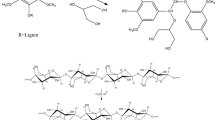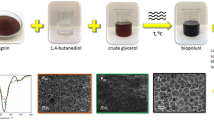Abstract
Microwave radiation was used as the heating source in southern pine wood liquefaction with PEG/glycerin binary solvent. It was found that microwave heating was more efficient than conventional oil bath heating for wood liquefaction. The wood residue content of the H2SO4 catalyzed liquefied wood dropped to zero within 5 min with microwave heating. The resulting liquefied wood polyols have suitable hydroxyl values for the preparation of rigid PU foams. Both the compressive strength and apparent modulus of the liquefied-wood-based PU foams increased as the isocyanate index increased from 80 to 120. The foams from H3PO4 catalyzed polyols had lower densities than those from H2SO4 and the petroleum-based controls. They also showed lower strength and modulus than those from H2SO4. Liquefied-wood-based PU foams generally have lower compressive strength and apparent modulus than the petroleum-based controls. However, they showed better restorability from deformation than the petroleum-based controls.
Zusammenfassung
Mittels Mikrowellenstrahlung als Wärmequelle wurde Southern Pine Holz mit PEG/Glycerin als binärem Lösungsmittelsystem verflüssigt. Es zeigt sich, dass Holz mittels Mikrowellenerhitzung effizienter verflüssigt werden kann als mittels konventioneller Erhitzung im Ölbad. Der Restholzanteil des mit Katalysator H2SO4 verflüssigten Holzes fiel nach fünfminütiger Mikrowellenbeheizung auf Null. Die Hydroxylzahlen der so verflüssigten Holzpolyole sind für die Herstellung von PU-Hartschaumstoff geeignet. Sowohl die Druckfestigkeit als auch die Steifigkeit der PU-Schaumstoffe aus verflüssigtem Holz nahmen mit steigendem Isocyanatindex von 80 auf 120 zu. Die Schaumstoffe der mit Katalysator H3PO4 erzeugten Polyole wiesen geringere Dichten auf als diejenigen mit Katalysator H2SO4 und als Schaumstoffe auf Mineralölbasis. Die Festigkeit und der E-Modul waren ebenfall geringer. PU-Schaumstoffe auf Basis von verflüssigtem Holz wiesen generell eine niedrigere Druckfestigkeit und eine niedrigere Steifigkeit auf als die Kontrollproben auf Mineralölbasis. Allerdings zeigten sie ein besseres Rückverformungsverhalten als die Kontrollproben auf Mineralölbasis.



Similar content being viewed by others
References
Allan G (1969) Hydroxyesters of bark phenolic acids. US patent 3476795
American Society for Testing and Materials (2004) Standard test method for compressive properties of rigid cellular plastics. ASTM D 1621-04a
American Society for Testing and Materials (2005) Standard test methods for testing polyurethane raw materials: determination of hydroxyl numbers of polyols. ASTM D 4274-05
American Society for Testing and Materials (2008) Standard test methods for polyurethane raw materials: determination of viscosity of polyols. ASTM D 4878-08
American Society for Testing and Materials (2008) Standard test methods for polyurethane raw materials: determination of acid and alkalinity numbers of polyols. ASTM D 4662-08
American Society for Testing and Materials (2008) Standard test method for apparent density of rigid cellular plastics. ASTM D 1622-08
Diao Y, Walawender W, Fan L (2002) Activated carbons prepared from phosphoric acid activation of grain sorghum. Biosource Technol 81:45–52
Ferrigno T (1967) Rigid plastics foams. Reinhold, New York
Hassan E, Shukry N (2008) Polyhydric alcohol liquefaction of some lignocellulosic agricultural residues. Ind Crops Prod 27:33–38
Hatakeyama H, Hirose S, Hatakeyama T, Nakamura K, Kobashigawa K, Morohoshi N (1995) Biodegradable polyurethanes from plant components. J Macromol Sci, Part A, Pure Appl Chem 32:743–750
Hostettler F (1979) Polyurethane foams containing stabilized amylaceous materials. US patent 4156759
Hostettler F, Barnes R, Mclaughlin R (1963) Polyurethane foams. US patent 3073788
Hsisiheng T, Tien-Sheng Y, Li-Yeh H (1998) Preparation of activated carbon from bituminous coal with phosphoric acid activation. Carbon 36:1387–1395
Jagtoyen M, Derbyshire F (1989) Some considerations of the origins of porosity in carbons from chemically activated wood. Carbon 27:191–195
Kappe O (2008) Microwave dielectric heating in synthetic organic chemistry. Chem Soc Rev 37:1127–1139
Kobayashi M, Asano T, Kajiyama M, Tomita B (2004) Analysis on residue formation during wood liquefaction with polyhydric alcohol. J Wood Sci 50:407–414
Koch H, Roper N (1988) New industrial products from starch. Stärke 40:121–131
Krzan A, Kunaver M (2006) Microwave heating in wood liquefaction. J Appl Polym Sci 101:1051–1056
Krzan A, Zagar E (2009) Microwave driven wood liquefaction with glycols. Biores Technol 100:3143–3146
Kurimoto Y, Doi S, Tamura Y (1999) Species effects on wood-liquefaction in polyhydric alcohols. Holzforschung 53:617–622
Lee S, Teramoto Y, Shiraishi N (2002) Biodegradable polyurethane foam from liquefied waste paper and its thermal stability, biodegradability, and genotoxicity. J Appl Polym Sci 83:1482–1489
Lee S, Yoshioka M, Shiraishi N (2000) Liquefaction of corn bran (CB) in the presence of alcohols and preparation of polyurethane foam from its liquefied polyol. J Appl Polym Sci 78:319–325
Shiraishi N, Kishi H (1986) Wood-phenol adhesives prepared from carboxymethylated wood. J Appl Polym Sci 32:3189–3209
Shiraishi N, Onodera S, Ohtani M, Masumoto T (1985) Dissolution of etherified wood into polyhydric alcohols or bisphenol A and their application in preparing wooden polymeric materials. Mokuzai Gakkaishi 31:418–420
Solum MS, Pugmire RJ, Jagtoyen M, Derbyshire F (1995) Evolution of carbon structure in chemically activated wood. Carbon 33:1247–1254
Wade L Jr (2006) Organic chemistry, 6th edn. Prentice Hall, New Jersey
Wang H, Chen H (2007) A novel method of utilizing the biomass resource: rapid liquefaction of wheat straw and preparation of biodegradable polyurethane foam. J Chin Inst Chem Eng 38:95–102
Wilson J, Fowler R (1958) Rigid urethane foams based on sorbitol derivatives. Science 128:1343
Wismer M, Gibsonia, Foote JF (1963) Method of preparing polyethers of mono and disaccharides. US patent 3085085
Wu L, Glasser W (1984) Engineering plastics from lignin. I. Synthesis of hydroxypropyl lignin. J Appl Polym Sci 29:1111–1123
Yan Y, Pang H, Yang X, Zhang R, Liao B (2008) Preparation and characterization of water-blown polyurethane foams from liquefied cornstalk polyol. J Appl Polym Sci 110:1099–1111
Yao Y (1996) Liquefaction of wood and other biomass in the presence of alcohols and its application. Dissertation, Kyoto University
Yao Y, Yoshioka M, Shiraishi N (1993) Combined liquefaction of wood and starch in a polyethylene glycol/glycerin blended solvent. Mokuzai Gakkaishi 39:930–938
Yao Y, Yoshioka M, Shiraishi N (1995) Rigid polyurethane foams from combined liquefied mixtures of wood and starch. Mokuzai Gakkaishi 41:659–668
Yao Y, Yoshioka M, Shiraishi N (1996) Water-absorbing polyurethane foams from liquefied starch. J Appl Polym Sci 60:1939–1949
Yoshida H, Mörck R, Kringstad KP, Hatakeyama H (1987) Kraft lignin in polyurethanes I. Mechanical properties of polyurethanes from a kraft lignin-polyether triol-polymeric MDI system. J Appl Polym Sci 34:1187–1198
Author information
Authors and Affiliations
Corresponding author
Rights and permissions
About this article
Cite this article
Pan, H., Zheng, Z. & Hse, C.Y. Microwave-assisted liquefaction of wood with polyhydric alcohols and its application in preparation of polyurethane (PU) foams. Eur. J. Wood Prod. 70, 461–470 (2012). https://doi.org/10.1007/s00107-011-0567-6
Received:
Published:
Issue Date:
DOI: https://doi.org/10.1007/s00107-011-0567-6




